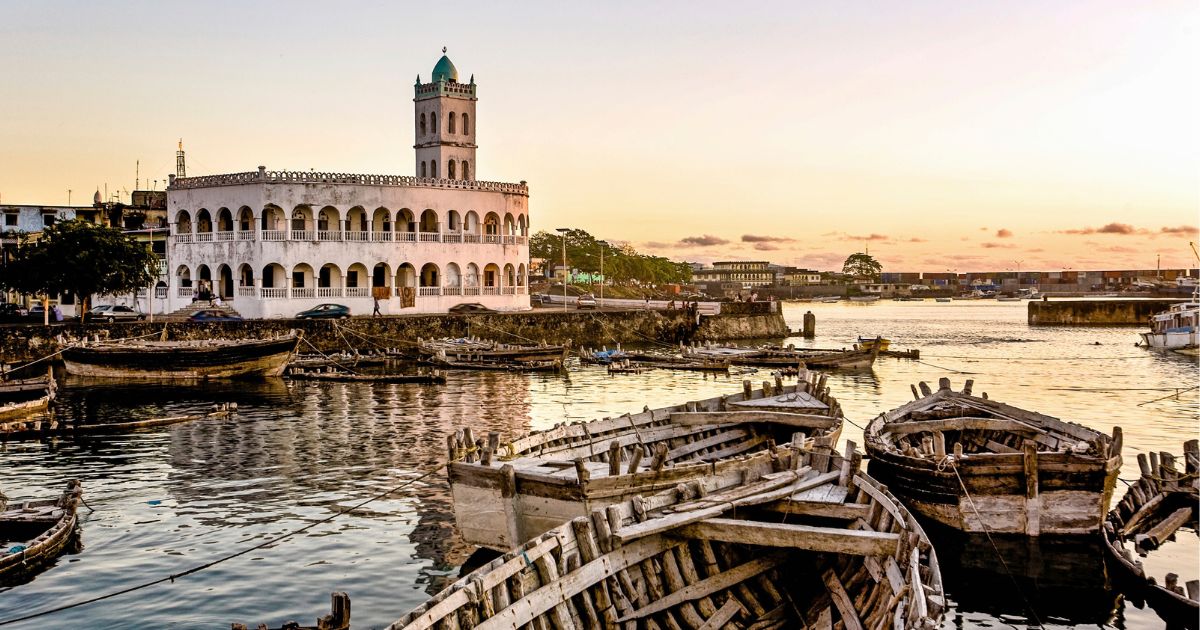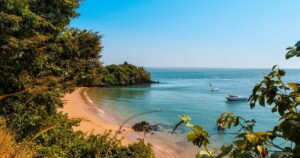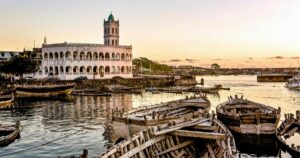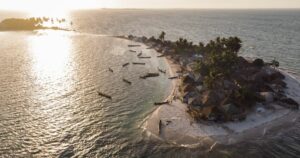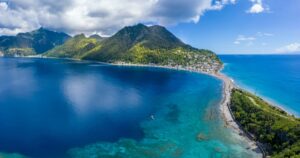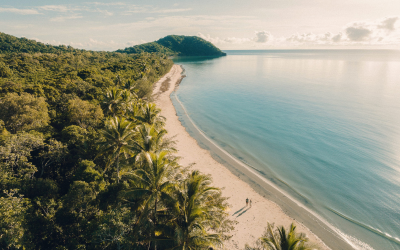These countries are barely visited but are safe to travel to and deserve much more love. Travel magazine Columbus Travel tells you why Comoros, San Marino and eight more countries deserve a spot on your bucket list!
1. Equatorial Guinea: pristine rainforest with 6,000 visitors a year
A visit to the vast Parque Nacional del Monte Alén, the highlight of the small Central African country of Equatorial Guinea, is definitely not a walk in the park. Tourist infrastructure in the form of hotels or campsites is lacking, but the oppressively hot and humid rainforest is teeming with wildlife: as many as sixteen species of monkeys, including gorillas, mandrils and red-headed mangabeys, more than a thousand elephants, crocodiles and the giant and up to three-kilogram Goliath frogs. For sea turtles and colonial architecture, travel to Corsico, although reaching this island is an even greater logistical challenge. At the crater lake of Lago Mazafim on the island of Annobón, you are guaranteed to be the only tourist.
2. Sao Tome and Principe: African dream destination with 8,000 visitors per year
A trip to the tiny island group of Sao Tome and Principe, some 250 kilometers off the coast of the Central African country of Gabon, is pure enjoyment. Especially on Principe, the northern island, you are one of the few travelers exploring the pristine rainforest, stunning beaches and rich marine life. Go with a shaman in search of beneficial plants in the jungle, hop in a kayak to explore the paradisiacal coast on your own, or plan your visit to coincide with the annual migration of humpback whales or the arrival of sea turtles.
3. Turkmenistan: Asian state secret with 14,000 visitors per year
Turkmenistan is the most closed country in Central Asia. Tourists are let in sparsely, but natural gas is the main source of income. Worldwide, only three countries have larger gas reserves. Near Derweze, surrounded by the desert sands of the Karakum, gas escapes into a fire crater that has been burning for 50 years. The heat near the edge of the seventy-meter-wide opening in the earth's crust is intense. The wildly flaring flames and a roar like that of a thousand gas fires burning simultaneously are hypnotic. Even without the pungent sulfur smell rising from the depths, it takes little imagination to see in the never-ending conflagration a Gateway to Hell, as local residents call this place.
4. Guinea Bissay: West African carnival secret with 22,000 visitors a year
Christians are a minority in Guinea-Bissau, but that doesn't stop residents of the West African country from celebrating carnival extensively. Every February, the streets of capital Bissau turn into a whirlwind celebration, with a parade of wooden boats, battered vehicles and revelers dressed in costumes adorned with shells, fish scales and cow horns. The colorful papier-mâché masks that ethnic groups make to represent their tribe can be found during carnival not only in Bissau, but also in the Arquipélago dos Bijagó, some 20 pristine tropical islands.
5. Comoros: African-Arabian island mix with 36,000 visitors per year
Culture, beach and nature. In Comoros, east of Mozambique, you'll find it all - but divided neatly among the three islands of Grand Comore, Mohéli and Anjouan. Most travelers spend most of their time on Mohéli, where there is excellent snorkeling off the beautiful private beaches. Nature lovers come there for the humpback whales, which swim to the island from Antarctica each year. The highlight of the third and least visited island, Anjouan, is - literally - Mount Ntingui.
6. Djibouti: African desert paradise with 51,000 visitors a year
Seek out French colonial architecture in the charming capital city, descend to the salty crater lake of Assal (the lowest point on the African continent), spot dolphins and whale sharks in the Gulf of Tadjourah, marvel at steam puffing limestone chimneys in Lake Abbe, and unwind to the silence of the desert - there are few countries so small and yet so varied.
7. Sierra Leone: West African bounty destination with 54,000 visitors per year
Traveling to Sierra Leone is advanced travel. There is no wifi, no reliable ATM and most accommodations have no running water. Consequently, this West African country is among the world's poorest and least visited. But on the other hand, you can still really explore. The beaches along the coast are paradisiacal. And if you want to go completely off the beaten track, off the coast lies an incredibly fascinating archipelago that has only been visited by a few hundred Westerners: the Turtle Islands.
8. Dominica: Caribbean odd duck with 63,000 visitors per year
The island of Dominica is virtually untouched by modernity. Dominated by five volcanic peaks, this wild hiking paradise is especially suitable for lovers of nature, tranquility and outdoor adventures. You will find dense jungle, 365 rivers, some amazingly beautiful waterfalls, narrow winding roads and many hiking trails. In the sea, sperm whales and good coral are fascinating attractions. On the Atlantic east coast cliffs await, on the Caribbean north and west coasts small sandy beaches and in the rainy the most beautiful trails.
9. San Marino: the oldest republic in the world, with 78,000 visitors a year
Surrounded entirely by Italy, San Marino is a country with two faces. Literally, because the oldest republic in the world is governed by two captain regents. All power in the hands of one person is a bad idea, even when your country has only 33,600 inhabitants. More striking is the contrast between day-trippers and visitors spending the night in the tiny 61-square-kilometer state. Whereas the narrow alleys of the capital located atop Mount Titano are clogged with tourists during the day, by nightfall you have the three imposing medieval towers Guaita, Cesta and Montale to yourself.
10. Liechtenstein: under-the-radar Alpine country with 79,000 visitors per year
Country collectors get a passport stamp before quickly leaving Liechtenstein again; avid alpinists opt for the more extreme peaks in neighboring Austria and Switzerland. As a result, it is remarkably quiet in this tiny 160-square-mile state. Another advantage: by hiking the Liechtensteiner Panoramaweg, a long-distance, 46-kilometer trail, you really see the entire country. The most beautiful - and toughest - part of the trail is the Fürstensteig. The dizzying path clings to the mountainside, exposed to the elements. Metal cables must prevent hikers from tumbling into the ravine. Once atop the Drei Schwestern, you look out at the rock arch through which the path leads, the minuscule Gafadurahütte far below you and gnome-sized houses in the Rhine Valley. Here Liechtenstein seems even smaller!

Between January 11 and 14, 2024, will you come to Vakantiebeurs to discover the cutest (unknown) countries?
